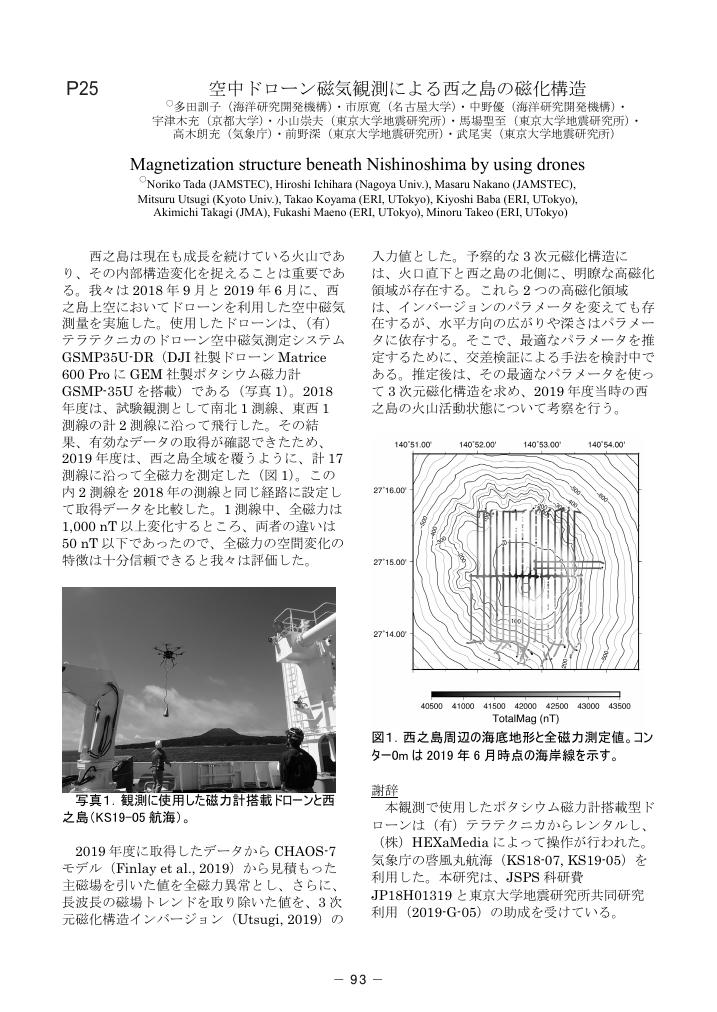- 著者
- 小川 康雄 馬場 聖至
- 出版者
- 日本地球惑星科学連合
- 雑誌
- 日本地球惑星科学連合2019年大会
- 巻号頁・発行日
- 2019-03-14
EPS (Earth, Planets and Space) is a peer-reviewed open access journal published on behalf of the following five societies; The Society of Geomagnetism and Earth, Planetary and Space Sciences, The Seismological Society of Japan, The Volcanological Society of Japan, The Geodetic Society of Japan, The Japanese Society for Planetary Sciences. These five societies are all society members of the Japan Geoscience Union.EPS was established in 1998 as a continuation of the two journals, the Journal of Geomagnetism and Geoelectricity (1949 to 1997) and the Journal of Physics of the Earth (1952 to 1997). In 2014 we started open access publication under the SpringerOpen platform. Open Access publication successfully shortened the publication time, increased visibility of the journal and widened its international readership. We publish average of 190 papers per year and half of the authors are from overseas. One of the qualification indices of the journal, impact factor (IF), is continuously increasing from 1.328 (2014) to 2.773 (2017) and it will also go over 2.6 in 2018. The increasing IF is supported both by increase of highly cited papers and by decrease of uncited papers, suggesting the success of quality control by the editorial board and possibly increasing of the visibility via open access.The scope of EPS covers Earth and Planetary Sciences, particularly geomagnetism, aeronomy, space science, seismology, volcanology, geodesy, and planetary science. The EPS share common scopes as well as a common journal platform with PEPS (Progress in Earth and Planetary Science). In contrast to PEPS, which emphasizes review papers, EPS is characterized by the following article types: (1) “Express Letter” which aims at fast publications, (2) “Technical reports“, which describe technical developments for scientific researches and (3) “Frontier Letters” for leading edge researches only with the invitation from the editor in chief. EPS promotes topical article collections (what we call special issues) on the first results of geoscientific events (earthquakes and volcanic eruptions) and scientific missions (satellite missions). EPS has been recently successful in attractive special issues. Aiming at fast and qualified review system, we have expanded editorial board members internationally since 2017. Now we have currently 50 regular editors (including 22 oversea editors). The oversea editors are 10 from Europe, 3 from North America, 5 from Asia, and 3 from Oceania.As part of the promotion of the journal we have four annual awards to recognize authors and reviewers: (1) EPS Excellent paper awards, (2) EPS Young researcher award, (3) Highlighted Paper Awards and (4) Excellent Paper Awards. From 2018, EPS has strengthened ties with JpGU. EPS has started collaborative advertisement activities at major domestic and international academic meetings, like JpGU, AGU, EGU and AOGS. EPS has updated the APC (Article Processing Charge) in September 2018 for sustainable operations of the journal.
3 0 0 0 OA 西之島の地球物理観測と上陸調査
- 著者
- 武尾 実 大湊 隆雄 前野 深 篠原 雅尚 馬場 聖至 渡邉 篤志 市原 美恵 西田 究 金子 隆之 安田 敦 杉岡 裕子 浜野 洋三 多田 訓子 中野 俊 吉本 充宏 高木 朗充 長岡 優
- 出版者
- 海洋理工学会
- 雑誌
- 海洋理工学会誌 (ISSN:13412752)
- 巻号頁・発行日
- vol.24, no.1, pp.45-56, 2018 (Released:2018-08-30)
- 参考文献数
- 12
Nishinoshima is an andesitic stratovolcano located in Ogasawara Islands, Japan. In November 2013, island-forming eruption started. Before the eruption, Nishinoshima was a small island of the area of 0.29 km2 and elevation of 25 m but it had a huge edifice rising 3,000 m from the sea floor. By March 2016, area and elevation reached 2.7 km2 and 140 m, respectively. We conducted various types of geophysical observations at this “difficult-to-access island” (950 km from Tokyo taking 90 min by Jet plane, or 24 h by ship). In June 2016, we conducted airborne observations using unmanned helicopter, collecting 250 grams of scoria and detailed 4K images of lava flows. OBSs (Ocean Bottom Seismometers) were deployed around Nishinoshima in four periods. From February 2015 to May 2017, characteristic waveforms dominated at 4–8 Hz band were frequently observed. Comparisons with infrasonic records and video images revealed that the 4–8 Hz seismic signals were associated with eruptions at pyroclastic cone. The number of seismic signals of this type declined from July 2015, and disappeared in November 2015, suggesting that the eruptive activity started declining in July 2015 and ceased in the middle of November 2015. In October 2016, we landed and deployed a broadband seismometer and an infrasonic sensor in the old Nishinoshima, collecting a lot of new lava, deposits, and ash samples. We demonstrated a capacity of remote-island volcano monitoring system for one day test navigation circling around Nishinoshima. After one and a half year quiescence, a new eruptive phase started in April, 2017. Our on-land seismic sensor detected precursory signals as early as April 17. The seismometer also recorded characteristic waveforms during the very early stage of the new eruption phase before data transmission was terminated on April 21.
1 0 0 0 OA 空中ドローン磁気観測による西之島の磁化構造
- 著者
- 多田 訓子 市原 寛 中野 優 宇津木 充 小山 崇夫 馬場 聖至 高木 朗充 前野 深 武尾 実
- 出版者
- 特定非営利活動法人 日本火山学会
- 雑誌
- 日本火山学会講演予稿集 2020 (ISSN:24335320)
- 巻号頁・発行日
- pp.93, 2020 (Released:2021-02-01)
1 0 0 0 OA プチスポット総合研究.岩石学と海域調査:海洋リソスフェア発達過程解明に向けて
- 著者
- 阿部 なつ江 馬場 聖至 荒井 章司 富士原 敏也 杉岡 裕子 鈴木 勝彦 山野 誠 平野 直人 中西 正男 道林 克禎 石川 正弘 町田 嗣樹 志藤 あずさ 伊藤 亜妃 仙田 量子 水上 知之 清水 健二 森下 知晃
- 出版者
- 独立行政法人海洋研究開発機構
- 雑誌
- 基盤研究(B)
- 巻号頁・発行日
- 2008
海洋プレートの非活動域に発見された新種の火山「プチスポット火山」海域において、地球物理学的・地質学的調査および岩石試料採取を実施してきた。同試料・データは、東北沖日本海溝に沈み込む前の海洋プレートそのものであり、陸側プレートに与える影響や島弧における火山および地震活動を評価する上で、重要な試料・データをもとに、海洋プレートとその下のマントル構造について総合的な研究・調査を行った。
